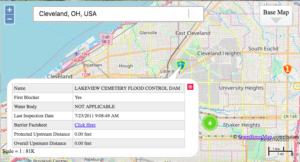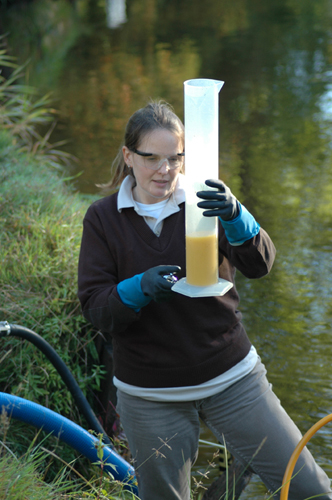Lampricide 101
Photo is used with permission from: GLFC. Caption: Manistique River treatment, T. Lawrence, GLFC.
In my previous post, relevant excerpts from an interview with Marc Gaden of the Great Lakes Fishery Commission regarding the invasive sea lamprey, Marc touched upon the idea of “lampricide.”
Basically, it’s a chemical solution to the sea lamprey problem. Other methods of controlling the population of sea lampreys, according to the GLFC, include physical barriers such as dams, lamprey traps, alarms and pheromones.
The most widely-used method of control, however, remains the application of lampricide. This method has been in use since 1958, according to the GLFC’s website. The chemical used most commonly is one called TFM, or “3-trifluoromethyl-4′-nitrophenol,” according to the GFLC. (A less commonly used chemical is known as Bayluscide.) In short, the chemical kills the lamprey in its larval form while sparing other flora and fauna. The lampricide use doesn’t affect humans, either.
It might sound strange that lamprey have larval forms at all — but this is part of their very unique life cycle. According to the New York State Department of Environmental Conservation, sea lamprey larvae hatch in rocky nests in tributaries, float downstream and bury themselves in silty areas of rivers and streams. They then spend years feeding off of floating “detritus” before beginning their transformation into parasitic adult lampreys.
Because lamprey are “at their most vulnerable” in their larval stages, according to the GFLC, lampricide is applied around every three to five years to streams where infestations of sea lampreys are found. TFM is then usually applied in the form of a liquid. In some cases, Bayluscide or a combination of Bayluscide and TFM are used instead. Lampricide serves to “disrupt energy metabolism in larvae.” In simpler terms, this means that sea lampreys cannot eliminate TFM from their bodies efficiently, and this causes their death.
In my previous interview with Marc Gaden, it seemed as if the use of lampricide as a method to control the population of sea lampreys was upheld as a “success.” That doesn’t mean, however, that there aren’t flaws in the use of lampricide. We touched on previously (and will again discuss in the article) the concern about the use of lampricide harming native species of lamprey. Another concern, though, is monetary.
According to the Minnesota Sea Grant’s website, around 175 Great Lakes streams are regular recipients of lampricide treatment — and it’s a costly method of controlling the population. The Sea Grant also alleges that the GLFC prefers to rely on alternative methods of lamprey control, such as the previously mentioned barriers and dams.
One helpful resource anyone can use to get a good handle on the sea lamprey control areas surrounding their homes or hometowns is the Sea Lamprey Control Map, an interactive resource created by the GLFC. The map allows users to enter a geographic area, such as the name of their city. The tool then looks up and displays the locations of nearby barriers, treatment areas, new treatment areas and trapping areas. For example, if we use Cleveland, Ohio, as an example in the Sea Lamprey Control Map, we see that there are several critical barriers to combat sea lampreys close to the city.
One such barrier is the Lakeview Cemetery Flood Control Dam, which can be seen in the image below. The information pop-up that the user sees when selecting the barrier location also provides a link to a barrier fact sheet, which records critical information about the dam. For instance, from this dam’s fact sheet, we can glean that it was built in 1978 and is 89 feet high, among other bits of information.

In short, lamprey control is a common and fairly routine measure of keeping the population of sea lampreys in check in the Great Lakes. And though the use of lampricide is pretty standard, there still seem to be some concerns and considerations with relying solely on the chemical to tamp down the number of sea lampreys in our waters. That’s why it’s probably good idea to keep informed about the environmental processes and procedures around you. Take a look at the Sea Lamprey Control Map for yourself! You might be closer to sea lamprey control than you’d think.
